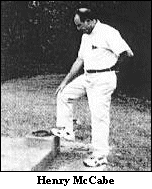|
Hope remains for forgotten fort By
SUSIE JAMES |
| Take the tour with Greenwood historian Henry McCabe, and, before long,
sounds of muskets popping fairly capture the imagination, the roaring
cannon blasts rip through the air, and life is injected into the ghosts of
a battle from 1863 at Fort Pemberton
Waving a hand toward the sheen of sunlight against the wet asphalt parking lot at Wal-Mart, McCabe said, "That's where the 35th Mississippi was camped." Veering right off U.S. 82 at Fort Pemberton Park, glimpses of the Tallahatchie River peek through the deep woods until there's the Racquet Club, and not far from it, the makings of a new house. "There was Fort Ann, and there, Fort Moore," McCabe said. A pumping station on Riverside Drive long ago commandeered the Civil War Fortification, Fort Texas, and a ramble east on Robert E. Lee, Middle Fort, and even farther, glimpsing back to the Tallahatchie, Lower Fort. There, cradled in the crook of the Yalobusha, the Tallahatchie, and the Yazoo was Fort Leflore. In the Tallahatchie, McCabe said, " The transport brought up by 2nd Texas, the John Walsh, came to the surface, a quarter of a mile east of where it was sunk, not far from The Star of the West." The John Walsh was back down by the end of the day. "I last saw Star in 1957-58," McCabe said, standing on the south bank of the Tallahatchie up from the Pemberton park, looking at the yellow waters flowing near the opposite bank -- waters covering what little must actually remain of the graceful, 228.4-Foot ship. The site is on the National Register of Historic Places. McCabe described how his father pointed the Star out to him when he was in seventh grade. "He said, "There's that battleship." I looked, but couldn't see what he was talking about. I realized later he was pointing at ribs of the boat, which could be seen when the water was quite low." The Star of the West drew the first shots of the Civil War in the darkness at Charleston Harbor Jan. 9, 1861, as she was used under lease from the U.S. government to try and reinforce Fort Sumter.
A raft was also sunk nearby, to try and clog the channel so Union forces couldn't proceed. Rebels dug-in at the fort, which was 2,400 feet long, 14 feet at the base, and 10 feet tall. Neither the ironclad Baron de Kalb nor the ironclad Chillicothe could fight its way past the Rebels. The fight three miles northwest of Greenwood marked the first time U.S. Naval forces were defeated by ground forces--and delayed the fall of Vicksburg by about 2 months. The battle at Fort Pemberton began the day the Star was sunk and ended April 5, 1863. Relics can still be found in the fields and waters of the area--but increasing construction makes it more and more difficult to visualize the Fort Pemberton area as it was during Civil War times. So far, efforts by McCabe and others to get the state or national park services involved in not only preserving what's left of the sites but also in setting up walkways, with teaching stations to illustrate Fort Pemberton's place in history, have fallen on deaf ears. As a local park created after land was donated by the Pillow family, Fort Pemberton seems largely forgotten. An abandoned concrete base on the southwest corner of the green bears the inscription: "Lady Polk, presented by Mildred Maury Humphreys Chapter No. 1198 U.D.C. Itta Bena, Miss., Oct. 20, 1933" even through the Lady Polk, a 12-pounder Blakely cannon has been at Greenwood's Cottonlandia Museum for safekeeping for a couple of decades now. "My hope," said McCabe, whose great-grandfather, Private Philip Hawker Selby, fought with the 37th Mississippi at Fort Pemberton, "is someone will help preserve this legacy." |
|
Courtesy of Henry McCabe, Greenwood, Mississippi |
 Three other transports were sunk in the bend of the Yazoo River
southwest of Fort Pemberton, and so was another, the Paragour, east of
them, all roughly during the same time as "Star of the West, a
historic sidewheeler steamer captured by Texas Confederates in 1861. The
ship was sacrificed in the Tallahatchie at Fort Pemberton March 11, 1863
to help Confederates prevent the Yazoo Pass Expedition of the U.S. Navy
from succeeding.
Three other transports were sunk in the bend of the Yazoo River
southwest of Fort Pemberton, and so was another, the Paragour, east of
them, all roughly during the same time as "Star of the West, a
historic sidewheeler steamer captured by Texas Confederates in 1861. The
ship was sacrificed in the Tallahatchie at Fort Pemberton March 11, 1863
to help Confederates prevent the Yazoo Pass Expedition of the U.S. Navy
from succeeding.